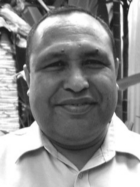Site Profile: The Port Moresby General Hospital, Port Moresby, Papua New Guinea
February 2007—Situated in the southwestern reaches of the Pacific Ocean on the second largest island in the world, the nation of Papua New Guinea has been largely untouched by the currents of globalization. This is one of the most rural places on earth—more than three-quarters of the population live in traditional societies and survive through subsistence agriculture. Yet Papua New Guinea’s isolation from the global economy has failed to protect it from the rapidly growing epidemic of HIV/AIDS.

Treatment scale-up remains a challenge in Papua New Guinea, according to Dr. Goa Tau of Port Moresby Hospital. (Photo: Dredge Kang)
|
With an adult prevalence rate pegged at 1.8 percent—a figure United Nations and AusAIDS experts indicate could actually be as high as 4.4 percent if surveillance strategies were more effective—Papua New Guinea is now facing a generalized epidemic that threatens to become one of the most severe in Asia. Here, HIV/AIDS is spread primarily through heterosexual contact—men and women are infected in almost equal numbers—and the prevalence rate has been rising by about 30 percent each year since 1997.
Port Moresby General Hospital, located in Papua New Guinea’s capital city of Port Moresby, is the newest site to join the TREAT Asia Network and it is one of only a few facilities in the country equipped to treat HIV/AIDS. The hospital’s AIDS team began to deliver antiretroviral therapy (ART) in 2004, the first year the drugs were available in Papua New Guinea. The team, which has functioned as a pilot program for AIDS care in the country, consists of 15 health-care professionals including doctors, nurses, a lab technician, and a counselor.
Although AIDS remains the most common cause of death at Port Moresby General—accounting for 24 percent of total mortality—death rates among HIV/AIDS patients have dropped dramatically during the three years since ART was introduced. In 2004, the death rate among patients with HIV/AIDS stood at 45 percent; in 2006, it had dropped to 2.5 percent. When death does come, its most common cause among Port Moresby’s AIDS patients is anemia, followed by pneumocystis carinii pneumonia and tuberculosis (TB).
According to Dr. Goa Tau, Port Moresby’s chief physician, treatment scale-up in Papua New Guinea remains a challenge. “Our antiretrovirals are 100 percent funded by the Global Fund,” he said. “We receive no government subsidy.”
With infection numbers rising each month and no indication that the government plans to contribute toward the cost of medication, the challenges faced by medical personnel at Port Moresby and across Papua New Guinea are considerable. Although the national treatment target for 2005–06 was 1,500 people, only about 800 received medication during that period, the majority of them at Port Moresby.
Almost 60 percent of new patients at Port Moresby present with severe weight loss, although fungal infections and diarrhea are common as well. But because viral load tests are not available, the hospital’s AIDS team makes its treatment determinations based on a combination of total lymphocyte count and the World Health Organization’s clinical staging system, which determines when to begin treatment based on sets of clinical symptoms organized into four stages of severity. Port Morseby’s patients, for example, commonly do not seek medical assistance until they reach WHO’s stages III or IV, which include symptoms such as unexplained severe weight loss, oral candidiasis, and pulmonary TB.

Despite a significant drop in HIV-driven mortality over the three years since ART was introduced, AIDS remains Port Moresby Hospital's most common cause of death. (Photo courtesy Port Moresby Hospital)
|
The most common drug regimen employed at Port Moresby, according to Dr. Tau, is the triple combination of AZT/3TC/nevirapine, received by 52 percent of patients, followed by D4T/3TC/nevirapine. “ARVs are quite effective in improving the quality of life for those taking their pills regularly,” said Dr. Tau. Significant weight gain, he noted, is a particulary good gauge of success in a resource-poor setting such as Papua New Guinea. Indeed Port Moresby’s data show that in the absence of ideal immune system monitoring tools such as viral load counts, lymphocite count, and weight gain can be useful indicators of drug effectiveness and adherence.
Despite the difficulties faced by the Port Moresby staff, the hospital’s AIDS team has established an effective treatment model that is now being expanded into more remote areas of the country. In mid-2006, five additional sites began to deliver ART, bringing hope—and life—to the growing numbers of people living with HIV/AIDS in this isolated country.